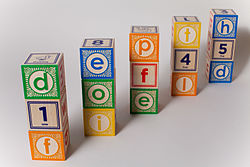This article needs additional citations for verification .(February 2019) |

Toy blocks, also called building bricks, building blocks, or simply blocks, are wooden, plastic, or foam pieces of various shapes (cube, cylinder, arch etc.) and colors that are used as construction toys. Sometimes, toy blocks depict letters of the alphabet.

